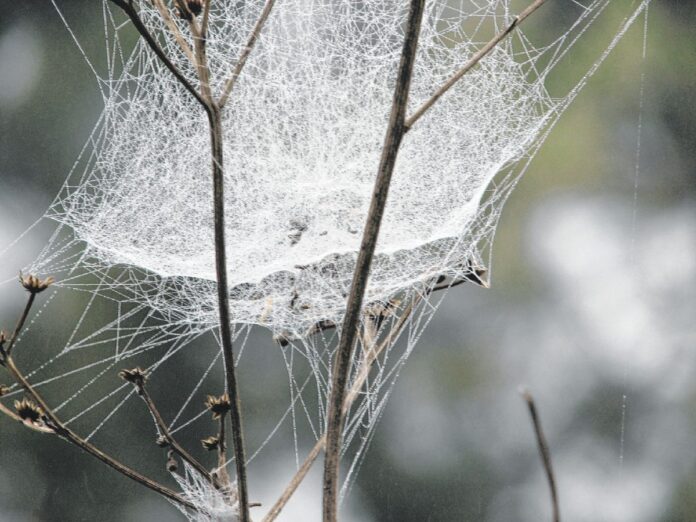
By LESLIE BISHOP, guest columnist
In late summer, nature’s fiber artists are busy.
Spider silk streams from powerlines, drapes the goldenrods, and even floats on air currents.
In the tall grass, sheets of silken platforms glisten, and closer observation reveals the silk-lined tunnel of funnel-web spiders.
The small woody shrubs lining the field host the delicate structures of the Bowl and Doily Spiders: a lacy sheet of silk under a cup-shaped platform with a chaos of threads rising above.
[sc:text-divider text-divider-title=”Story continues below gallery” ]Shimmering silk arranged in the wagon wheel of orb-weavers adorns the August wildflowers.
The early morning dew adds jewel-like sparkles to the glistening silk arranged in patterns that any artist would envy.
Unlike human artists who have to acquire their fibers, spiders produce their own silk. Inside the spider’s abdomen are special glands that secrete liquid protein into ducts which lead to the spider’s spinnerets located on the tip of the abdomen. As the liquid silk passes through microtubules in the spinnerets, water is absorbed, and the silk proteins are bathed in acid. As the silk extrudes from the spinneret, it is transformed by tension from a gel to a solid fiber.
Depending on the species, there can be three to seven types of silk glands, each producing proteins with unique amino acid compositions. The proteins from each type of silk gland will have specific properties useful for different functions: silk produced from different glands will vary in elasticity, durability, strength or stickiness.
To complicate the story, a spider may use more than one gland to produce silk for a specific task. For example, orb weavers have a special gland for producing the strong, spiral capture threads of their web, with yet another gland that produces a sticky coating for the same capture threads. Spiders use one gland to produce the particularly tough, waterproof silk for the outer cover of egg sacs, and they use another gland to produce the cement to attach the egg sacs to their webs.
Most of what we know about spider silk comes from studies on draglines. Draglines are used by many spiders as they explore their surroundings. The silk line functions as a bungee cord to protect the spider from an unexpected fall. The dragline silk is not only strong, but also highly flexible and extensible to hold the weight of the spider. Web spiders use draglines to drop suddenly from dangers such as a marauding wasp or hungry bird.
Draglines are also used by spiders that do not use webs, such as jumping spiders and wolf spiders, to find their way home. These spiders can retrace their steps by following the silken line.
Similarly, some species use draglines to find mates. The silk of a female spider is scented by pheromones to provide a guided trail for the male to follow.
Many of the physical properties of spider silk are yet to be discovered. For years, scientists have known that most spider silk is five times stronger than steel, yet the explanation for this phenomenon was only recently revealed.
In a recent study of the silk of the brown recluse spider, scientists found that each strand of silk used to create webs and hold eggs is actually a cluster of thousands of parallel nanostrands. The scientists used a specialized microscope with very high resolution to examine the silk at a molecular level.
Brown recluse spiders produce silk in a flat ribbon, unlike the cylindrical fibers of other spiders, and the flat shape allowed for accurate observation and measurements under the microscope. One silk strand has about 2,500 nanostrands forming a cable of incredible strength.
Spiders use silk to build webs, wrap their prey, line their burrows, protect their eggs, and disperse by ballooning through the air, among many other functions. But no matter how the silk is used, it is beautiful.
These fiber artists create the late summer scenes of silk-bejeweled vegetation that bring wonder and joy to the observer.
Leslie Bishop is a Brown County resident and retired biology professor from Earlham College. She can be reached through the newspaper at [email protected].




